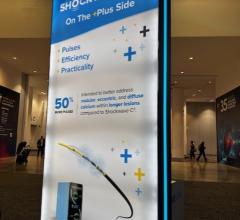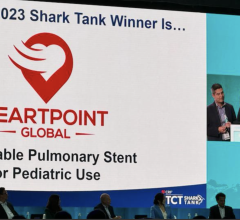October 30, 2015 — Results from a clinical trial showed that that the Abbott Absorb everolimus-eluting bioresorbable vascular scaffold was non-inferior after one year compared to a current generation metallic drug-eluting stent (DES) in patients with coronary artery disease for the primary endpoint of angiographic in-segment late loss (LL). Findings from ABSORB China study were presented at the 2015 annual Transcatheter Cardiovascular Therapeutics (TCT) scientific symposium.
ABSORB China was an angiographically based randomized trial designed to evaluate the relative effectiveness of bioresorbable vascular scaffolds (BVS) and cobalt-chromium everolimus-eluting stents (CoCr-EES); the trial was conducted for regulatory approval of BVS in China.
A prospective, randomized, active-controlled, open-label, multicenter trial, ABSORB China randomized a total of 480 eligible patients with one or two de novo native coronary artery lesions in a 1:1 ratio at 24 sites in China. Patients were randomized to BVS (n=241) or CoCr-EES (n=239). The primary endpoint was angiographic in-segment late loss (LL), defined as the change in minimal lumen diameter from post-procedure to one year, and powered for non-inferiority with a margin of 0.15 mm.
The primary endpoint of in-segment LL at one year was 0.19 ± 0.38 mm for BVS (n=200) compared to 0.13 ± 0.38 mm for CoCr-EES (n=195); the one-sided 97.5% upper confidence limit of the difference was 0.14 mm, achieving non-inferiority of BVS compared to CoCr-EES (Pnon-inferiority=0.01). BVS and CoCr-EES also had similar one-year rates of target lesion failure (cardiac death, target-vessel myocardial infarction, or ischemia-driven target lesion revascularization; 3.4% vs. 4.2% respectively, P=0.62) and definite/probable scaffold/stent thrombosis (0.4% vs. 0.0% respectively, p=1.0).
“Results from ABSORB China show that BVS was non-inferior to CoCr-EES for the primary endpoint of in-segment late loss at one year,” said lead investigator Run-Lin Gao, M.D. He is professor of medicine and chief cardiologist at Fu Wai Hospital, National Center for Cardiovascular Diseases, Chinese Academy of Medical Sciences in Beijing, China. “Similar one-year clinical safety and effectiveness outcomes were also observed. Additional studies are needed to assess BVS outcomes in complex patients and lesions encountered in daily practice, as well as long-term clinical outcomes data to assess the ultimate safety and efficacy profile of BVS compared to CoCr-EES.”
The ABSORB China trial was funded by Abbott Vascular. Gao reported receiving a research grant from Abbott Vascular.
For more information: www.crf.org


 May 05, 2025
May 05, 2025 









